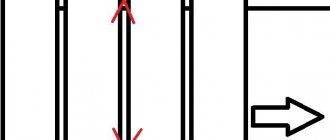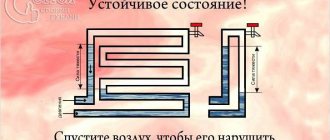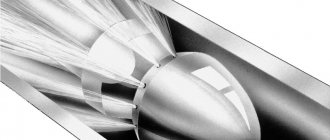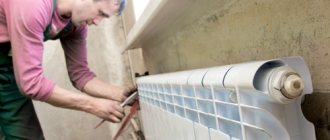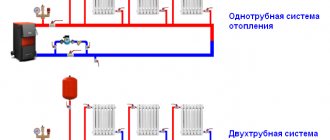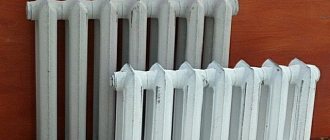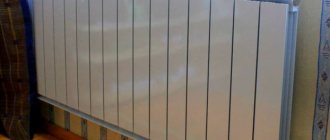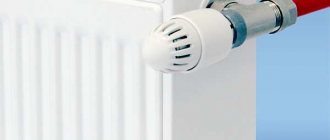Reasons and need for cleaning
Why is it necessary to make efforts to clean heating devices? Like any objects in a residential area, heating radiators become dirty, not only from the outside, but also from the inside. Dust accumulates on the surface of appliances, which can negatively affect the well-being of residents. In addition to dust, such devices often have greasy contaminants that are difficult to remove.
It is necessary to thoroughly rinse heating batteries if:
- the battery heats up unevenly - one part differs in temperature from the other even to the touch;
- the apartment warm-up time has increased compared to previous seasons;
- radiators are cooler than the thermal mains;
- For residents of private houses, a characteristic sign of the need for flushing is the fact of an increase in energy resources for heating, provided that heat transfer is reduced or maintained at the same level.
Contamination of heating batteries occurs due to changes in the quality of the liquid. This fact contributes to the settling of mechanical particles moving together with the coolant. After the end of the season, the water is drained, and corrosion often begins to develop inside the pipe. When the heating season resumes, under the pressure of hot water, corrosive particles begin to move and settle in the radiator. Over time, debris builds up, which can lead to blockages and poor performance. Thus, lack of cleaning can lead to a decrease in the heat output of the batteries while maintaining the same costs.
How to understand that the stove radiator is clogged
There can be many reasons why the stove does not heat well... Among other things, this is due to its radiator being clogged from the inside with products of coolant decomposition. To check its cleanliness, you need to check the temperature of the inlet and outlet pipes going to the heater radiator on a warm engine. So, if one of them is hot and the other is cold, it means the heater radiator is clogged. A clogged heater radiator will also be indicated by the fact that they are both hot but the heater still blows cold air.
Why do stove radiators clog?
The reason for a clogged heater radiator lies in the coolant. Firstly, in any antifreeze, over time, spent additives precipitate, and secondly, when the liquid is heated, scale gradually appears, and it can also cause corrosion of the surfaces of all elements of the engine cooling system. As a result, all that debris accumulates in the thin honeycomb tubes of the stove radiator. And if antifreeze or antifreeze is of good quality, then these processes occur very slowly, the liquid is of poor quality, then it’s not like a radiator, the engine can be ruined in a couple of years.
Do I need to rinse the inside?
The local heating system is installed mainly in private buildings that are located outside the city. The owner of the house himself updates the contents of the boiler. Batteries last longer because only fresh heating fluid circulates. They also need cleaning, but this is more of a preventative procedure. The general meeting is held less frequently, for example, once every 5 years.
Employees of the central heating organization update the contents of the line much less often. Most often, the oily substance is diluted with a new one, refreshing it. The volumes are not enough to update everything frequently. Thus, over decades, the liquid circulating through the radiators of high-rise buildings differs in composition from its original state.
Radiators gradually begin to give off heat worse. Insoluble elements or reaction products of the material with impurities of the circulating substance accumulate on the walls. Eventually, a blockage occurs, which leads to disastrous and costly consequences.
Regular preventive maintenance of the heat exchanger will help avoid troubles. You won’t have to worry about the fact that you will soon have to update your expensive heating system due to its failure.
To figure out how to clean any heating radiator yourself, you first need to know the nuances of the structure of modern radiator models.
Important: the main thing in such a situation is compliance with safety precautions. Having a product damaged during care is not the worst thing that can happen. It should be remembered that there is almost always liquid inside the battery.
Cleaning the radiator from the outside using special chemicals
On sale today you can find automotive chemicals for a wide variety of purposes, in particular, there are substances that allow you to quite effectively flush the cooling system the first time. However, it is worth saying that not every tool allows you to do this efficiently. There are substances that seriously disrupt the operation of both the engine and the car as a whole.
In this case, the rule works well - the cheaper the product, the worse it interacts with the radiator. It is best to use products for washing that are offered by world-famous companies producing automotive chemicals, which have also managed to gain a positive reputation.
These products are quite different in composition and purpose. In particular, some of them are added to coolant to act as an additive and prevent the formation of scale and rust.
In addition, you can find chemicals on sale that allow you to remove antifreeze leaks from the pipes or from the radiator. However, it should be used as carefully as possible, since it is quite viscous and its careless use leads to clogging of the tubes and thin hoses of the system.
Types
Before cleaning the heating system, you first need to determine the metal of the batteries.
Aluminum radiators cannot be cleaned in the same way as copper-brass and cast iron ones. This is due to the fact that the former do not use solder in their construction and this metal reacts negatively to caustic soda.
Aluminum is a more reactive metal than copper-brass and can be dissolved with caustic soda. Because of this, these radiators undergo a different cleaning process.
As long as the coolant is replaced and flushed regularly, aluminum radiators do not require flushing.
Copper-brass and cast-iron radiators can be cleaned using any available methods.
Features of radiators
In new or old Khrushchev-type apartments, cast iron batteries, so-called accordions, are installed predominantly. They are famous for their long service life and remain warm for some time after the hot liquid has ceased to be renewed. Cast iron withstands pressure drops in the system and poor-quality contents more easily. But such radiators are also more expensive.
Products made from bimetallic material are cheaper, thinner, and lighter. They are distinguished by increased heat transfer, but also cool quickly. They are easier to clean from the outside and look more attractive from an aesthetic point of view.
They don’t clog as often because they are made of a smoother material to which less dirt sticks. But bimetallic batteries more often burst, unable to withstand a sudden surge in pressure in the system. This is not uncommon at the beginning of the heating season or during sudden temperature changes. Therefore, they are preferred to be used in private homes or commercial buildings.
Aluminum products are the cheapest, but they are fragile and short-lived. Apartments with old heating systems quickly lose their functionality.
During the maintenance process, each type of battery must be considered individually.
Washing with acetic acid
You will need three bottles of food vinegar (70%).
They are sold in almost every supermarket. Also, don't forget to drain the old antifreeze. Remove the pipes leading to the heater radiator. After this, you need to use a compressor to blow out the remaining antifreeze and rinse the radiator with water. After drying, you need to pour vinegar into it and leave for about an hour. Then thoroughly flush the radiator fluid. To understand what the result of the procedure is, it is better to drain the water into a bucket. The older your “iron horse” is, the more obvious the result. The radiator will need to be blown out and dried again. Now you need to attach the pipes back, fill in antifreeze and start the engine. Simplicity: 5
Cost: 5 Time spent: 4 Quality: 5 Summary: recommended for moderate contamination.
Classification
Radiator cleaning procedures are divided into different types, depending on the auxiliary means used and the area of influence.
There are significantly more options, but only those that can be done independently and at home without the use of specific equipment will be covered.
Cleaning with hydrochloric acid solution
Another dangerous method that is not recommended without similar practical experience.
In addition, hydrochloric acid is quite difficult to obtain. Compliance with safety precautions, as in the case of using sulfuric acid, is simply mandatory. When using acid to get rid of heavy contaminants, you need to fill the cooling system with a 2% acid solution. You will need no more than 50 ml per 1 liter of water. After flushing the heating system, you need to carefully rinse it with water several times. Never use this method if the cooling system consists of parts susceptible to corrosion.
Simplicity: 1
Cost: 3 Time spent: 4 Quality: 5 Result: recommended in case of high levels of contamination.
Preparing for washing
Do not be mistaken that this is easy to do, especially when it comes to cast iron. But if you approach the situation wisely and your hands “grow from where they should”, two men will cope with the task.
Preparation technology:
- It is better to choose a day before mid-autumn, when services have already purged the main line, but water has not yet been released into the system. Ideally, you need to clean the batteries of all neighbors in the riser at the same time. Otherwise, dirt in a radiator located in another apartment will end up in yours, and the procedure will become useless.
- Draining water from the system in a private home is not difficult and can be done at any time. In an apartment building, you will have to negotiate with a plumber to carry out all the manipulations in the basement, where the distribution center of the house is located. You need to notify your neighbors if this happens during the heating season. Although the latter is resorted to when there is a blockage. It is better to carry out routine cleaning of radiators in the summer.
- If you have only superficial knowledge about the operation of batteries, their connection to the system and other nuances, it is better to first study the hardware. Or call a professional.
- Prepare a container in advance where the remaining liquid will drain.
- After unscrewing the element, you need to remove it. At this stage you will need an assistant. Even a bimetallic product is inconvenient to dismantle alone.
- The coolant should be inspected. Maybe there is no point in cleaning it anymore.
- If you plan to wash the product with water in the bath, you need to put something under it. For example. silicone mat. Otherwise, the scratches on the tank will be so serious that you will then have to pay for the restoration of the bathtub.
Tip: If the joints are welded, you need to use a cutter or other tool to heat the coupling.
Cleaning with lactic acid.
This method can give good results, but you won't find lactic acid in the supermarket.
Offers for sale are sometimes found on auto forums. Usually 36% acid is sold, but for cleaning you need 6%. Therefore, dilute the acid in a ratio of 1:5 in distilled water. Fill and wait until the formation of carbon dioxide stops. Then you need to drain the dirty liquid.
There are car enthusiasts who prefer to drive their car for several kilometers and only then drain the flushing fluid. However, be careful - despite the fact that this solution is not so aggressive on aluminum parts, the engine can become very hot. And, most importantly, do not forget to neutralize the acid by rinsing the parts with distilled water. The engine should run for about 15 minutes. Only after this can you add antifreeze.
Simplicity: 5
Cost: 4 Time spent: 5 Quality: 4 Result: recommended for moderate to high levels of contamination.
Cleaning methods
At the moment, there are several methods by which you can clean cast iron batteries from contaminants. Some craftsmen do all the work at home, while others prefer to turn to heating network workers for help.
We recommend: Installing heated electric floors
Each washing option has its own characteristics.
Dry cleaning
Dry cleaning involves everyday cleaning. Cleaning the outside of the battery is not difficult if you do it once a day or at least once a week.
Cleaning heating radiators from the outside:
- The vacuum cleaner comes with special attachments that can remove all the dust between sections if they are very close to each other.
- If you don't have a vacuum cleaner, you can use a hairdryer. We attach a damp cloth between the heating radiator and the wall. We direct the flow of hot air inside the sections and blow out all the accumulated dust. Thanks to the damp cloth, the dirt will not fall onto the carpet, but will stick to the rag. Then we rinse the cloth in clean water and continue cleaning other devices.
You can buy a special brush for heating radiators in the store. It will be easier for her to wipe off dirt. It is equipped with soft sponges that are very dense and allow you to clean the battery from several sides at once.
Wet cleaning
Use any detergent that can be used to clean the outside of a cast iron radiator.
Mix some liquid in a bucket of hot water, whip up foam. Dip the sponge and squeeze out excess water. Wipe the outside of the radiator, and don't forget about the piping and valves.
The wall behind the heating device can also be washed with soapy water.
Mechanical
For such cleaning, the pipes are disassembled. It effectively removes accumulated dirt, but is weakly effective against scale on the internal surfaces of the circuit. Before such flushing, close the valves before and after the boiler, then drain the water from the circuit using a drain valve. If it is not there, unscrew the cap on the radiator, which is located lower and farthest in the apartment. For greater efficiency, after draining the water, the batteries are dismantled.
To disassemble the radiator, use wrenches of the required size, including pipe wrenches. To do this, loosen the union nuts that connect the radiator to the pipes. The radiator is taken outside or into the bathtub, first covering it with thick textiles that protect it from mechanical damage. After washing, the textiles are discarded. The drain in the bathtub is covered with a mesh to prevent clogging of the sewer.
They clean the radiator with a cable and use it to clean the pipes. You can remove the primary dirt into a previously prepared container to reduce the load on the sewage system. For greater efficiency, before flushing, you can disassemble the radiator into sections of 2-3. After cleaning, the battery is washed by directing a stream of water into the internal circuit. To do this, use a hose with an adapter, ensuring the tightness of the hose connection. Stop washing when the outlet water becomes clear.
Dispersed
Biological flushing is an improved modification of the chemical method for removing clogged radiators. However, the action of the reagent here is somewhat different from the original method. The diluted reagent entering the system does not destroy the structure of metal radiators: its action is aimed at molecular rupture of the compounds of metal and compressed dirt. This method is applicable to batteries made of different materials, which is convenient and does not cause leakage.
The solutions used are not harmful to humans, so there are no problems with the disposal of waste material. During the washing process, dirt comes out of the batteries in a split form, so its pieces do not clog the radiator and pipe passages. After treatment, a special hydrophobic film is formed on the surface, which prevents the formation of new limescale deposits inside the circuit.
The process is carried out as follows:
- calculate the amount of reagent based on the characteristics of heating systems;
- prepare the device as in the chemical method;
- the device is connected to the system, the pump is turned on, liquid is introduced into the system circuit;
- after the required time, the waste material is drained into the sewer;
- flush the system with water several times;
- the system is filled with clean water.
When performing flushing during the heating season, you need to connect a device that closes the heating system.
Hydrodynamic
This technique involves supplying thin jets of water under high pressure to the heating system. Special nozzles are used for it. Water will not be supplied from a tap using a hose, but through a pump under pressure. Using this method, it is possible to stop the supply hose in particularly problematic areas where flushing is required. The method is considered environmentally friendly and effective for cast iron radiators.
However, it is not so easy to do it at home, because equipment that can provide water pressure of several hundred atmospheres is not cheap. In addition, such washing requires experience, which may require calling a specialist. Another disadvantage is the fact that the deposits must first be softened with a special solution, which is different for each battery material.
Hydropneumatic
This method involves flushing the heating system by supplying high pressure air inside the circuit. It is carried out through the inlet or outlet of one of the radiators, using a compressor, which is connected through a check valve. This connection prevents water from entering the system. The compressor supplies steam, creating a turbulent flow with high energy. This causes the build-up of compressed rust inside the circuit to be torn off and washed out of the system.
To flush radiators in this way, turn off the water. After this, a compressor with a pneumatic gun is connected to the radiator. When the batteries are not dismantled, the cap on the farthest one is unscrewed and a hose is connected through an adapter, which will collect debris. He is taken to the toilet. The first air supply, which is a short-term pulse, is carried out in the direction opposite to the circulation flow of the system.
Re-injection is performed by changing the direction of the air. To do this, the supply and collection hoses are swapped. To make the method more effective, you can dismantle the radiator, although this is more troublesome. The batteries can be taken outside, where it will be easier to wash them. After washing, they are put in place, then the circuit is connected to the coolant and the system is started to wash out any remaining dirt.
Then turn off the water supply, remove the drain hose, and put the plug in place. Now the system can be put into operation. The method is based on shock waves, of which a total of 2 to 5 may be needed. This flushing method does not take more than a few minutes if the radiators are not removed. It does not depend on electricity, since the installation operates autonomously. Its disadvantage is the limited range of action, which depends on the technical characteristics of the air gun used.
Electrohydropulse
This cleaning is carried out using electric discharge energy, which destroys scale and salts deposited inside the circuit. However, the batteries and pipes are not damaged. This method requires special equipment, although its efficiency is high, and the process itself does not require disassembling the heating system. The shock wave will destroy existing scale. And after the process, all that remains is to rinse the system with clean water to get rid of deposits that have lagged behind the walls.
This method is an alternative to replacing batteries. It is based on the application of an electrical charge in water and does not require a large amount of energy. After using a special installation, the heat exchange surfaces are completely cleaned of silt and lime deposits, which increases the internal cross-section of the circuit to the factory size. In this case, you can clean radiators and pipes of any configuration. A coaxial cable with special equipment at the end is placed into the pipe. During operation, periodic electrical discharges are created, which creates powerful waves and hydrodynamic flows, due to which effective cleansing occurs.
We recommend: Pressure testing of the heating system - the most complete information
Chemical
If you wish, you can clear communications yourself. But this is quite labor-intensive work, the complexity of which is determined, first of all, by the weight of the heating equipment.
During work using the chemical cleaning method, there is no need to violate the integrity of the system - disassemble the batteries into sections. It is most suitable when communications are installed in an autonomous heating system, that is, a private house, cottage or apartment.
The cleaning of cast iron heating radiators itself is carried out using chemical elements - reagents that are sold in many stores. If desired, improvised means can be used, for example, soda ash or caustic soda.
Cast iron radiators can also be washed with composite solutions, alkalis, organic and mineral acids in small proportions. Each container of chemicals has clear instructions to follow during cleaning. The fact is that these elements, with which batteries are cleaned, are aggressive substances. They affect not only scale and deposits, but also the material from which the radiator is made.
To extend the service life of the equipment, it is enough to clean it once every 3-4 years.
Often, when washing on their own, users make a serious mistake - they prepare an acid solution that is too concentrated. A large concentration of the washing solution will easily “eat up” the contaminants, and with them the sealing elements of the device. This may cause the batteries to leak. Chemical liquids should under no circumstances be used to clean aluminum radiators, unless it is a specially designed preparation.
If you lack skills, it is not recommended to carry out the work yourself, otherwise there is a possibility of permanently damaging the equipment. It is best to turn to specialists who have everything you need.
If you still want to do the cleaning yourself, it is not recommended to use too strong substances.
The best options are the salt of ethylenediaminetetraacetic acid or a more gentle option in the form of citric acid.
Hydrogen peroxide
A good helper in the household is 3% hydrogen peroxide. This well-known substance perfectly cleans and disinfects batteries. To use, add ¾ of a bottle to 2-3 liters of water. To remove severe stains, you can use pure peroxide by applying the substance directly to the stained area or with a sponge.
Lemon acid
Using citric acid, you can not only effectively clean the radiator from contamination, but also get rid of the unpleasant odor. As a rule, the smell appears from stagnant water and flower fertilizer that has reached the surface of the radiator. To prepare a cleaning solution, you will need to dissolve 3 tsp in a glass of water. citric acid.
Baking soda
Regular baking soda is suitable for cleaning the battery. To do this, dissolve 2 tbsp in 3 liters of water. l. soda For greater effect, you can add 1 tsp. apple cider vinegar and 7 drops of any liquid soap.
Vinegar 9%
Vinegar is poured into a spray bottle for further spraying onto the stained area, previously cleaned with a damp cloth. Afterwards, the battery must be thoroughly rinsed with water and wiped. Vinegar essence mixed with water in a ratio of 1:10 can also be used. When spraying in the room, the windows should be open; it is better to protect the respiratory tract with a mask.
Use of special compounds
Effortlessly, in just a few minutes, special cleaning products will help remove dirt and grease stains. To remove greasy stains, you can use dishwashing detergents, for example, Fairy, Pemolux, MYTH. Before use, it is necessary to dilute the concentrate in water, foam it and wipe the surfaces of the radiator with a brush or sponge. Light stains can be removed with laundry soap. Complex contaminants can be removed using special household chemicals intended for plumbing fixtures and household appliances, for example, Domestos, Krot, Tiret. Old stains are removed using stain removers, for example, “Vanish” and “Antipyatin”.
Using special equipment
At the moment, there are several types of special equipment used for cleaning batteries.
For domestic purposes this is the following equipment:
- pneumatic pistol "Typhoon";
- device for electrohydropulse influence ZEVS-24;
- Krot-Mini device.
Typhoon
The air gun is a compact and easy-to-use device. Thanks to its targeted effect on blockages, it can clean water and sewer pipes with a diameter of no more than 150 mm.
The essence of cleaning is a hydraulic ram, which, moving at a speed of 1.5 km/h, removes hardened deposits from the walls of the equipment. The maximum distance of the shock wave reaches 60 meters. The use of a pneumatic gun is important if conventional hydraulic flushing does not produce results.
ZEUS-24
Despite its small size, this equipment is powerful enough to destroy hardened deposits firmly stuck to the inner walls of pipes. It can be used to clean products with a diameter of seven to 150 mm.
The working principle is as follows: the device creates an electrical discharge, resulting in a shock wave and powerful hydrodynamic flows. The ZEUS-24 installation allows you to clean hard-to-reach bent and spiral pipes.
Mole Mini
This installation cleans communications with a diameter of 20 to 150 mm - intra-house sewer networks and other pipelines. Thanks to the spiral installed in the drum, cleaning hard-to-reach places is easier.
The device is used in many sectors of human activity: from housing and communal services, hotels, gas stations to industrial enterprises.
Electrical appliances
Thorough cleaning of the battery can be done using electrical appliances. It is important to take precautions.
Vacuum cleaner
You can use a vacuum cleaner for cleaning. It is advisable to use a narrow nozzle, this will allow you to penetrate hard-to-reach places. First you need to remove all dust and debris from the inside, then treat the outside. When finished, you can wipe the radiator with a damp cloth.
Hairdryer
To use a hair dryer, you must first place a towel or any thick cloth soaked in water under the radiator. Direct a stream of hot air onto the radiator. The dust will move from the battery to the damp cloth. Not the most effective way: dirt can remain between the sections, get into the air or walls, floor.
Washing vacuum cleaner
A good alternative to a regular vacuum cleaner. It will cope perfectly even with serious dirt. Cleaning should begin from the inside, and then proceed to the outer surface. A washing vacuum cleaner, thanks to an aqua filter, can prevent the spread of dust throughout the room.
How to flush a car heater radiator
On modern cars, heater radiators are made of two main materials - copper and aluminum. For aluminum radiators you need to use acidic agents, and for copper radiators - alkaline compounds. You cannot use alkaline solutions to clean aluminum radiators, as its surface will immediately begin to oxidize, and the clogging situation will only worsen or even ruin the part!
List of products that can be used for washing aluminum and copper stove radiators.
| Means | Radiator type | The need to dismantle the radiator when flushing | |
| Aluminum | Copper | ||
| Lemon acid | ✓ | ✓ | × |
| Table vinegar | ✓ | ✓ | × |
| Lactic acid or whey | ✓ | ✓ | × |
| Battery electrolyte | ✓ | ✓ | ✓ |
| Caustic soda | × | ✓ | ✓ |
| Orthophosphoric acid | ✓ | ✓ | ✓ |
| Boiled or distilled water | ✓ | ✓ | × |
| Special professional products | ✓ | ✓ | × |
Flushing the stove radiator with citric acid
Using citric acid, you can clean radiators made of any metal, both aluminum and copper. There can also be several proportions and recipes for its use. One of them is to take 20...40 grams of dry acid and dissolve them in one liter of water. If the radiator is heavily clogged, the amount can be increased to 80...100 grams per liter (increase the volume of the flushing mixture proportionally). Ideally, the acid solution should be checked using litmus paper - the pH value should be 3 . This is the optimal composition for cleaning the stove radiator.
The acid solution can be used according to the methods described above, pouring it inside. An alternative is to pour it into the car instead of antifreeze, and start the engine for 30...40 minutes, let it idle or take it for a drive, and then leave it overnight. Then drain the liquid; if it is very dirty (with a lot of sediment), the procedure should be repeated one or two more times. After this, rinse the cooling system with ordinary distilled water and add new antifreeze.
Washing with vinegar
Acetic acid is another affordable and effective means for cleaning both the cooling system in general and the stove radiator in particular. To prepare the washing solution, you will need 500 ml of table vinegar, which must be diluted in 10 liters of boiled or distilled water. Otherwise, you can proceed by analogy with washing with citric acid. This composition is suitable for radiators made of both copper and aluminum.
Serum wash
Flushing the stove radiator with serum
The lactic acid present in the serum perfectly washes plaque, rust, and debris from the walls of both aluminum and copper radiators. However, it is quite difficult to find lactic acid in its pure form, so the easiest way is to use natural (this is very important!!!) whey.
To clean the stove radiator you need 5...10 liters. Before use, you need to strain the whey through a filter a couple of times in order to remove any pieces of fat from it!
Most often, it is poured into the system and rolled for about half an hour, and then drained and the system is washed with hot distilled water several times, since the whey contains fat.
Flushing the stove radiator with electrolyte
Battery electrolyte also removes various deposits and deposits well. Almost any electrolyte can be used in sufficient quantities. It can be used to clean both copper and aluminum radiators (but not for very long!). When working with electrolyte, be sure to wear work clothes, rubber gloves, a respirator and safety glasses.
After removing the radiator, fill it with electrolyte and leave it for a couple of hours so that a chemical reaction occurs, during which the dirt and plaque will dissolve. Then drain and wash. Only the first time the water used should be with a small amount of baking soda (1 tablespoon per liter). And then it is advisable to use a cyclic “run” of water through the insides of the radiator.
Washing with caustic soda
Caustic soda is a caustic alkali, it can have several names, caustic soda, sodium hydroxide, caustic. used to clean aluminum radiators, only copper ones and even after removing them from the car , because it has a detrimental effect on the aluminum parts of the cooling system.
And to clean the radiator, use a 10% solution of caustic soda. When making it, personal protective equipment is needed, because if it gets on the skin, caustic can cause a chemical burn. Before use, the resulting solution must be heated, then poured and left for several hours, then drained. If necessary, repeat the procedure two or three times until the liquid being poured out is relatively clean. When finished, be sure to rinse the radiator with clean boiled or distilled water.
How to rinse with phosphoric acid
Phosphoric acid, or rather its 85% solution, sold in specialized stores, is also well suited for cleaning aluminum and copper heater radiators. It is used on radiators removed from cars. You need to work in personal protective equipment, gloves, and a respirator.
You just need to pour the acid inside the radiator and leave it there for a couple of hours. After this, rinse thoroughly with boiled or distilled water. It does not corrode the metal, but instead dissolves the plaque and rust that has formed inside.
Washing with water
The simplest, but most ineffective remedy is ordinary boiled (this is important!!!) or distilled water. However, if you just want to rinse the radiator with water, you need to do this under pressure. As a rule, it is not used in its pure form, but only as a rinse after some kind of product.
Special means for flushing the stove radiator
For those who do not trust traditional “old-fashioned methods,” auto chemical manufacturers have made ready-made products that are specifically designed for cleaning the car’s cooling system.
Popular product LIQUI MOLY Kuhler-Reiniger
- LAVR Radiator Flush Classic . Can be used to flush radiators made of both aluminum and copper. Sold in cans of 430 ml and 980 ml. A small can is designed for a cooling system volume of 8…10 liters. Therefore, its quantity must be calculated in accordance with the volume of the radiator. Instructions are on the package. It is noted that the product perfectly removes rust, limescale, dirt and other debris. The price of one small can as of summer 2021 is about 400 rubles.
- LIQUI MOLY Kuhler-Reiniger . The product is also intended for cleaning the cooling system. Can be used to clean radiators made of any metal. Removes rust, plaque and debris well. sold in a 300 ml metal can, which is designed for a 10 liter cooling system. Costs about 625 rubles.
- Hi-Gear Radiator Flush . A distinctive feature of washing is that it cleans within seven minutes. Can be used to clean any radiators made of aluminum or copper. One 325 ml can holds 17 liters. The price is about 290 rubles.
Please note that old radiators may leak after flushing, since debris accumulated inside could simply seal the housing. Therefore, after washing with special means, it is necessary to rinse the radiator from the inside with water and carefully examine it for leaks at the seams.
Cleaning cast iron radiators is not a problem
Rinse the cast iron heating radiator, as it is heavy, which in itself is inconvenient. In addition, due to the design features, it silts heavily.
To remove a cast iron battery you will have to work hard - as a rule, the connecting couplings and taps are rusted, so it will be difficult to unscrew them. Start by draining off any remaining water. To do this, unscrew the plug at the top, place a basin or other container under the bottom and begin to unscrew it easily.
We recommend: Ventilation for a gas boiler in a private house: requirements for the system, its types, power calculation and installation
Important!!! On cast iron radiators, the plugs can be with either left-handed or right-handed threads.
If the plugs are painted, use solvent or White Spirit to remove the paint from where it connects to the section. After that, try to unscrew it with a gas wrench. If it does not flow, use a rust converter, for example, WD-40.
When the remaining water has been drained, it is necessary to disconnect the cast iron radiator from the common line. Usually it is mounted on special couplings (see photo). As with plugs, couplings can also become rusty. Instead of couplings, valves, taps or fittings can be installed. In this case, you will need to unscrew them.
Such couplings usually connect pipes in heating systems with cast iron radiators.
It is best to wash a cast iron battery in a bathtub, which must be completely covered with rags or rags so as not to damage the enamel coating or acrylic.
First, clean the bottom and top using rags. You may need something like a metal rod to remove any stubborn dirt, especially at the bottom.
After this is done, you need to tighten the plugs at the bottom of the cast iron radiator and pour liquid or flushing solution into it. Let it sit for as long as required by the rules of use, then drain it by unscrewing the bottom plug.
Screw the cap back on at the bottom and fill all sections with hot water. Let it sit for 3-5 minutes and drain. Repeat the procedure until the water coming out is as clean as the water coming in.
The level of contamination of cast iron radiators is higher than bimetallic and aluminum ones. Therefore, repeat the cleaning procedure again. You may have to do this 3-4 times.
Battery flushing
It is most convenient to wash batteries in large containers . Considering the low weight of the products, the best option would be to process the equipment in a bath. The first cleaning is carried out without the use of chemicals . The radiator is filled with water and dirt is mechanically removed from it using shaking.
The spent contents of the device should be poured out , and special reagents should be poured . The solution is kept inside the battery for about an hour , after which the equipment is knocked with a wooden hammer or shaken to remove any remaining rust and dirt. At the end, the device is rinsed in running water .
Cleaning with citric acid.
One of the cheapest and most accessible methods of descaling. The rinsing solution is easy to make yourself. It is necessary to dissolve 200 g of acid in warm distilled water. Sometimes it is recommended to add a little vinegar. The resulting liquid must be heated. After this, you will need to drain the old antifreeze and add flushing fluid. Next, we take a break and use the car as usual. After 3-4 days, drain the liquid, which should remove all dirt and scale particles. After that, fill in the antifreeze and the work is finished.
Simplicity: 5
Cost: 5 Time spent: 3 Quality: 5 Summary: recommended for moderate contamination.
Flushing the heating system in a private house
In private homes, cleaning heating radiators is a more pressing problem. This is explained by the fact that the water in the heating system of a private house does not come from pipes, but from wells or reservoirs. The water that comes from pipes in residential buildings is treated, but well water is not. In private homes, radiators become dirty a little faster, as silt or other small particles can accumulate in them, so cleaning radiators will be required more often. If you live in a private house, it is better to flush the entire heating system, and not just the radiators.
Cast iron pipes can be washed in the warm season, the main thing is not in winter. Before you wash the radiator and the entire heating system, you need to bleed the air from the radiator, so you will need to unscrew all the valves. If you doubt your abilities, it is better to call a specialist who will not only bleed the air from the heating radiator, but also completely carry out such an operation as cleaning the radiators. If you make even a small mistake, you can damage the equipment or cause a flood.
There is no need to drain water from the heating boiler. The line for the steam line must be completely closed before cleaning the heating radiator. If all the necessary valves are closed and the heating radiators are purged, then you can run water through the heating system. It is necessary to supply water until clean water begins to flow from the pipes.
This method will help clean not only radiators, but also pipes.
To carry out such an operation as flushing a heating radiator more effectively, you can add some chemicals to the water. These include vinegar, soda, whey and others. For washing, a product such as “Mole” or a product for cleaning car radiators is suitable.
If various chemicals are used to clean radiators, you will need to rinse the system thoroughly with water after using them. It is best to flush the system with hot water, and this will require turning on the boiler. A procedure such as cleaning heating radiators should be carried out at least 2 times a year.
What product can be used to clean the outside of a car radiator?
The radiator becomes clogged while using the car due to the fact that dust and debris fly into the car from the road one way or another. This part gets dirty much faster if the vehicle is driven on country roads or in areas where there is serious dust.
Insects can also get into the radiator, which later turn into a rather solid mass along with dust.
To clean the radiator without removing it, you can use ordinary water, which will clean its outer surface, but it is often not very easy to get to this part of the car.
To carry out high-quality cleaning, the radiator is often removed.
It even happens that ordinary cleaning of the outside with water turns out to be insufficient, since the dirt has settled so firmly that it cannot be removed from the surface using traditional methods.
To get rid of contamination, use a special product to clean the outside of the vehicle radiator.
As a rule, the heating radiator or air conditioner radiator is washed with running water, but in car washes this is done under quite high pressure. In this case, the operation must be performed as carefully as possible, since here it is possible to damage the honeycombs, which will simply cause a radiator leak. It will eventually lose its seal.
If salt sits on the radiator along with dirt, it should be removed from the surface of the part as quickly as possible. The fact is that the part is made of aluminum, and a saline solution can corrode it in just a few minutes. As a result, this will end in the same car radiator leak.
It is also worth noting that water is unlikely to be able to remove stubborn deposits, which means that you will have to use a special product to rid it of dirt.
There are quite a lot of chemicals developed specifically so that chemical cleaning of the radiator can be done without removing this part.
Chemical products produced by the following manufacturers are widely popular among drivers:
- Hado;
- VERYLUBE;
- Liqui Moly.
There are also universal cleaning agents on sale that can be used to clean not only dirt from the radiator of a car’s engine cooling system, but also from the entire engine.
The cost of such a substance can vary greatly - it depends on which company produced this product. In particular, the cost of one bottle, the volume of which will be about 250 ml, can reach a thousand rubles.
It is not advisable to purchase products that are too cheap, since inexpensive drugs may use too active substances, which can be as harmful as the pollution itself.

